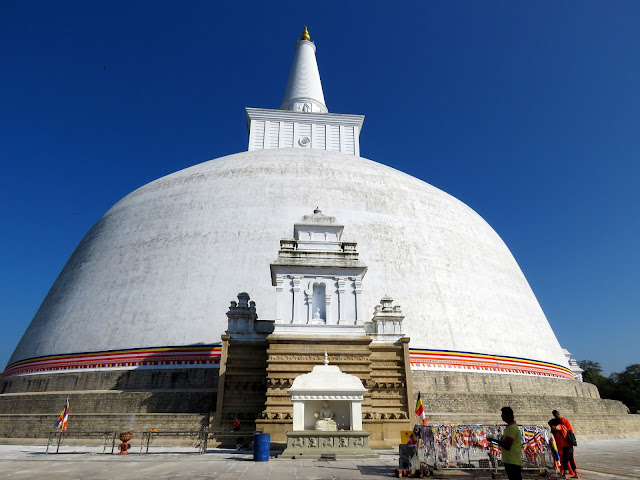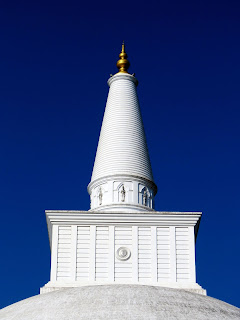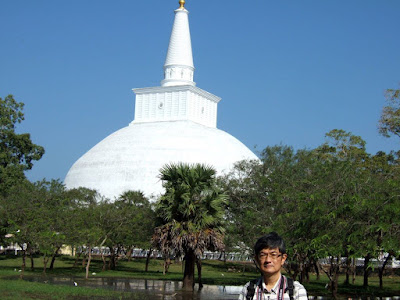
The mega structure of Maha Ruwanweliseya Stupa, also known as Ruvanmali Dagaba or Mahathupa Stupa, was constructed more than 2000 years ago by King Dutugemunu (161-137BC). Measured at 103 meters in height and 290 meters in circumference, it was not only the most venerated and most adorned stupa built in ancient Sri Lanka but also was one of the largest monument erected in the ancient world. The supremely glorious ancient living monument of Sinhalese Buddhist heritage built in 140BC, is now an Unesco World Heritage site and an essential pilgrimage site for all Buddhists today.


The construction of this architecture marvel was clearly and faithfully recorded including its causing and reason of building it. It was said that the monument was a prediction of Lord Buddha and it was designed by Arahats and enlightened ones. According to legend, the site where the Great Stupa stands had been graced by three past Buddha and Gautama Buddha during his third visit to Sri Lanka. It was also the site of an inscribed pillar erected within 250-210BC by King Devanam Piyatissa, under the guidance of Mahinda Thera.



The foundation of Maha Ruwanweliseya Stupa was laid by King Dutugemunu. The inscribed pillar erected 200 years ago earlier was removed and land was leveled during a full moon Wesak day. Foundation was dug to a depth of 7 cubits, spread with crushed round stones pieces stamped by elephants with feet covered with leather. Materials like Himalaya fine clay, layers of bricks, iron network, rock crystals, stone slabs, mixture of mercury, wood-apple resin and fine clay were spread layers over layers. Followed over all the mixture layers were 8 inches thick bronze sheets and 4" silver sheet. It was said that such process repeated seven times. Each time it completed, the Arahat would made it sink into the earth, allowing space for the next foundation. The strong foundation was said to strengthen the monument to withstand the severe natural disaster like earthquake. King Dutugamunu spent 64 million silver coins for the project as all people worked for the job were paid. Unfortunately, The Great King did not live to see the completion of his great task. The job was continued and completed by his brother King Saddatissa after he passed away.


The Relic Chamber of Maha Ruwanweliseya Stupa that contained the relics of Lord Buddha had never been excavated since it was built. It was said that the walls of the chamber were adorned with murals depicting the Samsara cycle of Buddha and there was a silver made Bodhi tree. The casket that contained Lord Buddha's Relic was made in gold and decorated with gold, silver items and gems. It was placed on a Vajrasana diamond seat sealed inside with stone slabs by Arahants.



King Dutugamunu passed away prior to the completion of Ruvanmali Dagaba. The decorative frontispieces, enclosure for deities, sand and stone terraces, spiral and pinnacle were mostly done by the subsequent Kings of Sri Lanka.



The four frontispieces at four cardinal points are impressive.



Devoted Buddhists flock in almost every day to make flowers or light offerings, to circle round the sacred stupa or just medicated at the terraces.


Buddhists believe that circle round a Relic Stupa or Pagoda will have a good rebirth, will be distanced from eight disasters and be safe whenever you go.



Puja meal offerings are made before noon every day by monks.




Scattering around the square terraces are some interesting features like the gorgeous statue of Queen Vihara Maha Devi, mother of great King Dutugemunu (161-137BC), the artistic carved balustrade and particularly memorable spot where people adorn it with flags and coins.



The old carvings remained at walls.


Some ancient stone tablets used may be for lighting incense or candle




The lions wall





Its 344 life-size elephant heads with tasks lining around the front wall are most amazing.


The beautiful striking flowers are Sal, a sacred fragrant flower like lotus that are used to make offering for Buddha.


Majestic Ruvanmali Dagaba viewed from the surrounding wetland.




The architectural marvel is indeed a great surprise to the builders of modern world.



Wetland nearby the stupa is home to many wild life.




Strolling under the shade of the massive trees along the pathways in the holy precinct of Great Ruvanmali Dagaba, listening to the legends of the glory history of Buddhism in the ancient Sri Lanka, time was as if return to the past.



Many ruins are unidentified. The terrace space between the Great Stupa and Lovamaha Prasada was Panamba Maluwa, the site where the body of Thera Mahinda laid in state before cremation. It was said that the place was also where Mahavihara monks assembled to distribute the 4 requisites (robes, alms, medicine and shelter) they received from public.


The ruins at the east gate was believed to be a hospital. A berth Orval medicinal stone trough was found at site.



Mahavihara monks' Catussal Alms hall was believed to be built in 3rd century BC by King Devanampiyatissa. Its 45 feet long trough boat was able to cater rice for 3000 monks.



Ramsimalaka Convocation Hall was an ancient building used as an assembly hall for Mahavihara monks. There are 8 rows of pillars with 10 pillars each with no walls in between remained at site. It was believed that the hall was an opened structure without roof.



The Brazen Palace Lovamaha Pasada was built by King Dutugamunu (161-131BC) as a chapter house in Maha Vihara Complex for Sangha. It was originally built with nine storeys with roof covered with copper plates. Monks lived in rooms according to their seniority. The senior monks occupied rooms at 8th or 9th floor.


Lovamaha Pasada had 1000 chambers and the building was mainly supported by 40 rows of pillars at 40 pillars each. It was said that its balconies were decorated with lotus motifs and hung with silver bells .


Ponds were always an essential feature came along with monastic buildings in ancient Sri Lanka.


The chattering monkeys are one of the inhabitants around the Great Stupa. They moved freely within the area and volunteer to look after the booth at site.



Joys of Peace came from these soft green grass that nourished under crystal morning dew.


No comments:
Post a Comment